I was scouting around the West 50’s recently when I noticed a really interesting building on West 59th I’d never seen before, tucked away in the shadows of the bland modern high-rises surrounding it.
The building looked to be in great shape despite its age, and two features in particular caught my eye…
First, this odd cone-shaped roof, which appeared to be equal parts glass, tin, and tiles…
…Second, and more revealing, the sign above the door, which identifies the building as…
The William J. Syms Operating Theatre of the (adjacent) Roosevelt Hospital, built in 1891. In fact, this was once the very first modern OR in the United States:
William J. Syms, a gun merchant, was the patient of renowned Roosevelt Hospital surgeon Charles McBurney, and after a successful operation costing $300, sent a whopping $3,000 as payment. McBurney returned the money with a note that he couldn’t accept it. Years later, when Syms died, he left $350,000 to Roosevelt Hospital, specifying that $250,000 be used to create an “operating theatre” under McBurney’s direction.
Here, a picture of the operating theater from the February 25, 1893 issue of Harper’s Weekly (just two years after it was built)…
…and the same angle from today:
The operating theater was designed to the recommendations of Gustav Neuber, a German surgeon who was essentially the first to advocate that OR’s be sterile environments. He wrote a book detailing his findings, suggesting the use of non-porous, easily washable building materials, tables and shelves of metal and glass, minimal furniture, and avoiding corners where dust could accumulate. Here, a picture from an unspecified date (you car nuts might be at least able to identify the decade)…
…and today:
The operating theater was in use for 30 years, then became a blood bank. It was abandoned in the 1970’s and fell into ruin. Here, more pictures from the 1893 Harper’s article:
Doctors and nurses at work:
Inside the halls:
A sterilization area (I think):
As developers began building up the block in the 1980’s, a restoration project was started to save the Syms Operating Theatre. Salvage yards were scoured for the correct type of brick, the enormous red oak doors were repaired, and the central skylight was replaced, ultimately bringing it back from the dead:
As I was taking a pictures, a guard came out and told me an interesting fact. As you walk up to the front door, you’ll notice a break in the fence to your right…
…and if you look closely, you’ll see a path leading to a cement area. According to the guard, members of the Roosevelt family (who had donated money and land to found the hospital) were once buried here, but their bodies have since been removed.
I’m curious then if this is just a garden ornament, or something left over from their grave:
As the two enormous high rises were built over the operating theatre, the decision was made to keep it free-standing. In other words, you could completely tear down the bland modern apartment building that straddles it, and the OR would remain like it has been for over 100 years.
Though the insides have been completely gutted, the gorgeous exterior stands as a monument to an important achievement in medical history, and thankfully looks like it will be around for quite a while to come.
-SCOUT
PS – For a more detailed history on the Syms Operating Theatre, check out this lengthy article here.

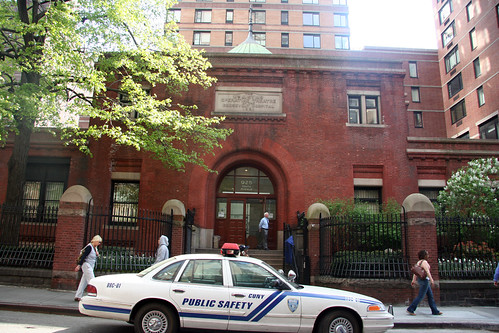
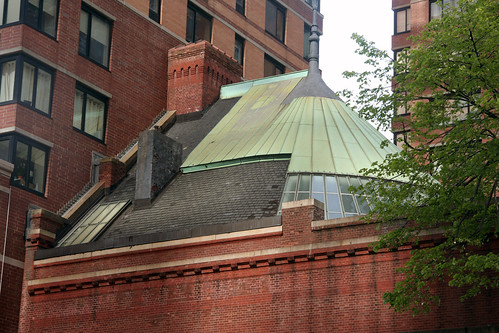



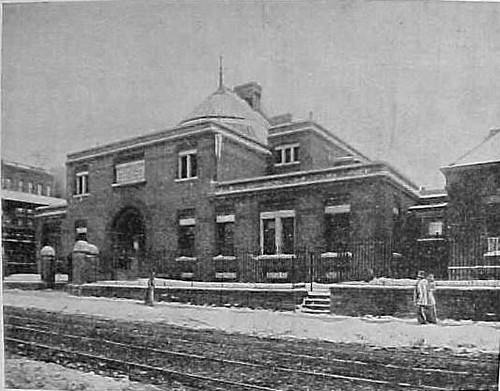

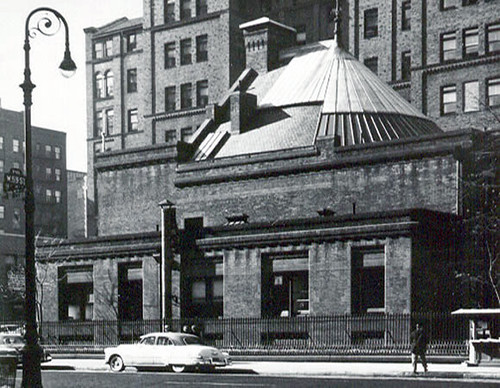
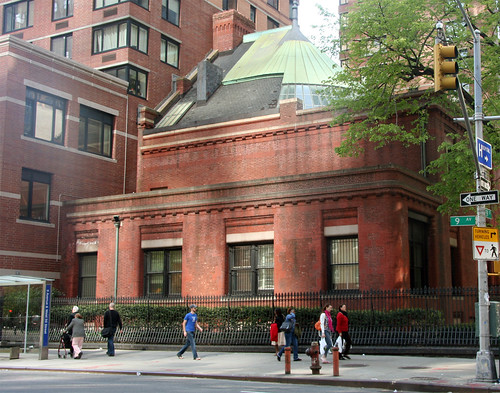
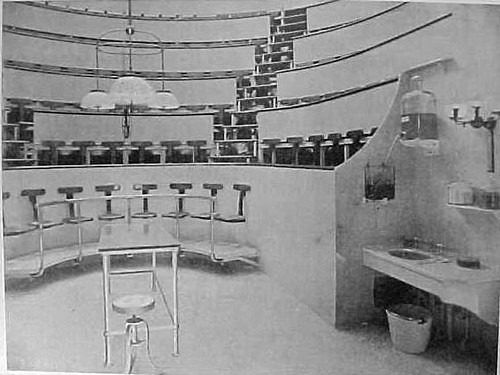
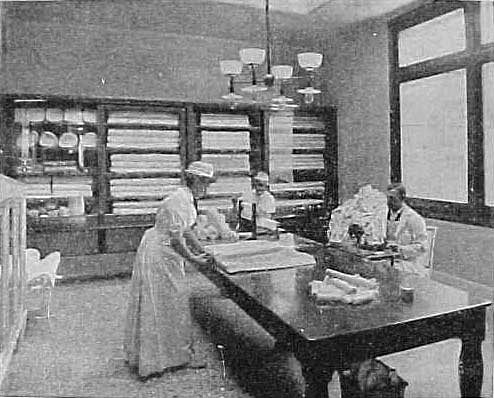


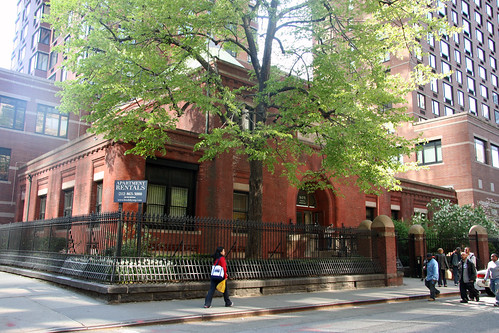

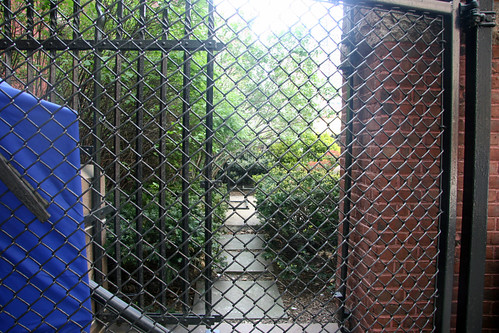
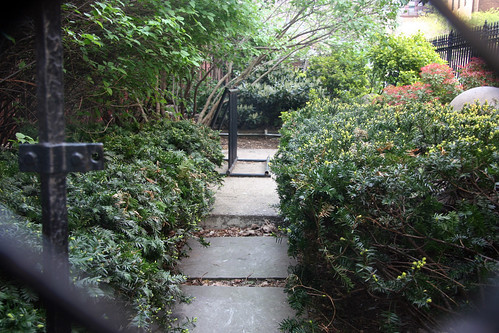

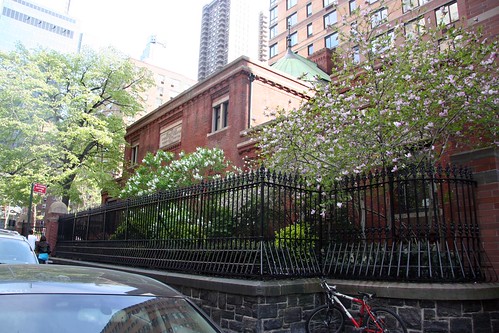


I’ve lived in Manhattan for 40 years, which means I’ve probably walked past this dozens of times without stopping to take it in.
Great find, and thanks for the history!
Great post! I didn’t know McBurney practiced in NYC — though every medical student is taught another location associated with this famous surgeon:
http://en.wikipedia.org/wiki/McBurney's_point
How sad that the interior has been gutted! It would be magical to see one of those old-time operating theatres, like one sees in movies from the ’30s.
This is a wonderful article. By chance a photo of what a typical 1900s operating room looked like was posted on Shorpy a few days ago. It’s a little scary.
http://www.shorpy.com/node/8009
What is the place now? Is it apartments? Is it a functioning part of Roosevelt Hospital?
Thanks so much for this. I can remember walking by this when it was a wreck, then seeing it renovated. Nice to get the history. Beautiful building.
I walk pass this every so often, on my way from the gym to El Centro restaurant, on 9th Ave. I a;ways admire it and have wondered if the interior was intact. Sad to know that it’s not, but at least the exterior is in good shape. Thanks!
Very cool stuff, Scout.
The nation’s oldest surgical theater is still intact, just a couple of hours away in Philadelphia: http://www.uphs.upenn.edu/paharc/tour/tour5.html
It is still open to the public for tours and was even the site of a theater piece a few years ago.
For years there was in the small ivy garden next to this building on the Columbus Avenue side, a small sign that designated that area as dedicated to Ethel Merman. In the late 70’s she worked as a “candy striper” here at this hospital while both of her parents were being treated. That image stuck with me and blew my mind. Every time I would pass by and see it – I would smile.
Fascinating!!
Roosevelt Hospital in general is also known for it being the Emergency Room where John Lennon was prononuced dead.
Interestingly, my grandmother told me she got her tonsils removed here in the 1930s or 40s… I should try to find out more info!
More on the Roosevelt being buried there…
http://www.chpnyc.org/slrhcalumni/founders.html
Roosevelt Hospital may have built a sterile operating theater in 1891, but in 1900 the hospital at the Brooklyn Navy Yard was still doing things the dirty, old-fashioned way.
Pingback: Other Ten Percent » Blog Archive » Other Ten Percent 4/20/10
I’ve been working at Roosevelt Hosp for the last 4 years and did know any of this! I’m just on the medicine side of things and not surgery, so maybe the surgeons know more about this history. It’s pretty cool to know! Will definitely change how I look at the building when I walk past it at work!
That article you linked claims the building was demolished… Someone needs to check their facts, and don’t worry, it’s not you
I am lucky enough to work in this fabulous building. The morgue in the basement has been since turned into a conference room (creepy). Thanks for the great photos and history.
Well, since you asked…
That pic with the sedan parked out front dates the shot to as early as probably 1950, with what looks like a ’50 Chevy, but I’m having a hard time seeing the detail on the taillights to be exactly sure.
It’s definitely the early half of the Fifties, judging from the slivers of the other cars that can be seen on the left side of the image, though…
Hi, I always enjoy your posts and was very pleased to see you feature this building.
To my knowledge, it’s the sole extant work of architect William Wheeler Smith, AIA, (c.1838-c.1908) (http://en.wikipedia.org/wiki/W._Wheeler_Smith), a largely unappreciated architect, speculative developer, and philanthropist, who designed a number of minor office, ecclesiastical, and institutional NYC landmarks. His most remarkable design was the brownstone St. Nicholas Collegiate Reformed Protestant Dutch Church (1872) on the northwest corner of Fifth Avenue and Forty-eight Street, which had a spire that the New York Times wrote “many declare…the most beautiful in this country.” It was cleared 1949 for the Sinclair Oil Building.
Smith was a self-made man who became exceedingly wealthy and this operating theater project attracted his interest in hospitals. In 1908, his will left the majority of his $3 million fortune to St. Luke’s Hospital. The will had been amended to favor St. Luke’s over previous beneficiaries Columbia University and pensioner charity. The funds directed the hospital to build a sanitarium for poor convalescents, which he had hoped to design but fell ill before he could undertake the project.
The Syms Operating Theater is discussed in my article on early NYC neurology ( http://www.cumc.columbia.edu/news/journal/journal-o/winter_2009/moses.html ). Dr. McBurney performed some of the world’s first brain operations there!
I used to park my car not far from this building so I’m quite familiar with it. When I saw the operating room scene in Spider-Man 2, it immediately sprang to mind.
Thanks for this. I grew-up two blocks north of here on Columbus Avenue in the sixties and seventies. This along with St. Paul’s church are the only original buildings left standing.
Pingback: The tale of two hospitals: Enjoy the "inexpressibly nauseating" aromas of Brooklyn's oldest operating theater - Bowery Boys: New York City History
Pingback: The tale of two hospitals: Enjoy the "inexpressibly nauseating" aromas of Brooklyn's oldest operating theater - Bowery Boys: New York City History